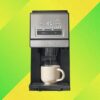As we begin to assemble the ingredients for the obe ata—a tomato, sweet pepper, and hot chile purée that serves as the base for the efo riro, and many other West African dishes—I mention some of the other Nigerian dishes I’ve been learning about recently. I tell her about chef Kwame Onwuachi’s recipe for suya, the extremely-hard-to-stop-eating grilled skewers that are rubbed with a potent mix of ground peanuts, ginger, cayenne, and more before cooking. At his restaurant in Washington, DC, Onwuachi serves suya with soubise, a French tomato-cream sauce for dipping, a fact that elicits a jovial laugh from Seriki, as if to say “see?” Those third-culture kids, she tells me, “they’re always making stuff up.”
So okay, sure, Seriki’s not a third-culture kid. But after spending the day with her, it was clear: she’s a third-culture cook.
“In the 80s, you could not find yams here,” Seriki says, referring specifically to the five-pound Ghanian variety she likes best, as well as the more general category of African yams with white flesh and tough, hairy grey-brown skins that must be peeled away with a paring knife—they’re very different from the orange-fleshed sweet potatoes many Americans call by the same name. The same was true for the spices and other flavorings she was accustomed to buying in Lagos. So when Seriki first moved to New York, she would frequent Latin markets, which often carried similar ingredients. “Many of our foods were brought to the Caribbean” by enslaved Africans, she says, which means “many Latinos eat some of the same things we do.”
Today there is a large African market near her home (although she still petitions family and friends who visit from Nigeria to pack an extra suitcase with ingredients that remain elusive). And yet even so, the Nigerian recipes Seriki cooks in her kitchen in the Bronx continue to be infused with flavors you wouldn’t find in the most traditional recipes. It’s a shift that happened organically: When she was learning to cook non-Nigerian recipes, she says she “would go to the grocery store and see different sauces or [unfamiliar] ingredients, and would just buy them and come home and try it.” Occasionally, those impulse purchases made their way into her Nigerian recipes.
Source link







